Coleophora directella is a moth of the family Coleophoridae. It is found in most of Europe, except Great Britain, Ireland, the Iberian Peninsula and the Balkan Peninsula. It is also known from China.
Pancalia nodosella is a moth in the family Cosmopterigidae. It is found in Portugal, Spain, France, the Netherlands, Germany, Austria, Italy, Slovenia, Slovakia, most of the Balkan Peninsula, Ukraine, Latvia and Russia. In the east, the range extends through the Caucasus and Central Asia to Kyrgyzstan.

Agonopterix ciliella is a moth of the family Depressariidae. It is found in most of Europe, except the Iberian Peninsula, most of the Balkan Peninsula and the Benelux. It is also found in North America.

Agonopterix conterminella is a moth of the family Depressariidae which is found in Asia, Europe and North America. It was described by Philipp Christoph Zeller in 1839 from a specimen found in Augsburg, Germany. The larvae feed on the terminal shoots of willows.
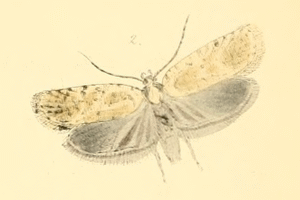
Agonopterix nanatella is a moth of the family Depressariidae. It is found in most of Europe, except Fennoscandia, Poland, Ukraine, the Baltic region and most of the Balkan Peninsula.
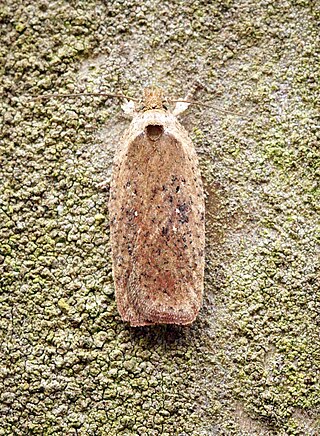
Agonopterix scopariella is a moth of the family Depressariidae. It is found in most of Europe, except Ireland, most of the Balkan Peninsula, Ukraine, Finland and the Baltic region.
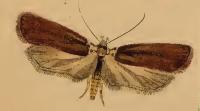
Agonopterix cnicella is a moth of the family Depressariidae. It is found in most of Europe, except Ireland, Fennoscandia, Portugal, the central part of the Balkan Peninsula, Latvia and Estonia. It has also been recorded from Morocco and Asia Minor.
Perittia farinella is a moth of the family Elachistidae. It is found in most of Europe.

Bucculatrix demaryella is a moth of the family Bucculatricidae. The species was first described by Philogène Auguste Joseph Duponchel in 1840. It is found in most of Europe, Russia and Japan.

Luquetia lobella is a moth of the family Depressariidae. It is found in most of Europe, except Ireland, the Iberian Peninsula, Finland, Estonia and most of the Balkan Peninsula.

Semioscopis avellanella is a species of moth of the family Depressariidae. It is found in most of Europe east to the eastern parts of the Palearctic realm.

Semioscopis oculella is a species of moth of the family Depressariidae. It is found in most of Europe east to the eastern parts of the Palearctic realm.
Anchinia daphnella is a species of moth of the family Depressariidae. It is found in most of Europe, except the Iberian Peninsula, Great Britain, Ireland, the Benelux and Greece. In the east, the range extends to the eastern part of the Palearctic realm.
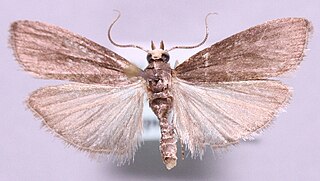
Salebriopsis is a monotypic snout moth genus erected by Hans-Joachim Hannemann in 1965. Its single species, Salebriopsis albicilla, was first described by Gottlieb August Wilhelm Herrich-Schäffer in 1849. It is found in most of Europe, except Ireland, Portugal, most of the Balkan Peninsula and Ukraine.
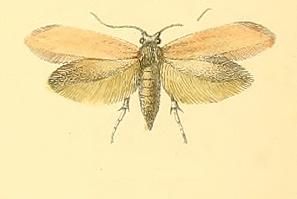
Argyresthia bergiella is a moth of the family Yponomeutidae. It is found in most of Europe, except Ireland, Great Britain, Belgium, the Iberian Peninsula and most of the Balkan Peninsula.
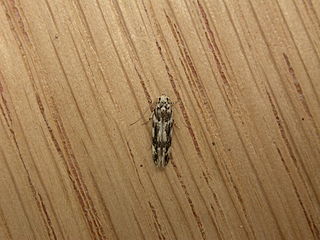
Parachronistis albiceps, the wood groundling, is a moth of the family Gelechiidae. It is found in most of Europe, except the Iberian Peninsula and part of the Balkan Peninsula. Outside of Europe, it is found in southern Siberia, the Russian Far East and Korea.

Argolamprotes micella, the bright neb, is a moth of the family Gelechiidae. It is found in most of Europe, except Ireland, the Iberian Peninsula and most of the Balkan Peninsula. Outside of Europe, it is known from Siberia, the Russian Far East, the southern Kuril Islands and Japan. The habitat consists of hedgerows, open woodland and gardens.

Carpatolechia notatella, the sallow-leaf groundling, is a moth of the family Gelechiidae. It is found in most of Europe and Turkey.
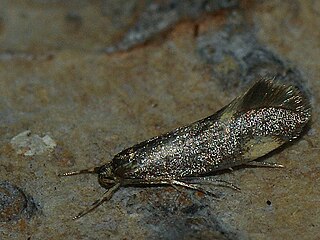
Metalampra cinnamomea is a moth of the family Oecophoridae. It was described by Philipp Christoph Zeller in 1839. It is found in most of Europe, except the Iberian Peninsula, most of the Balkan Peninsula, Ireland and Great Britain.

Celypha rurestrana, the hawkweed marble, is a moth of the family Tortricidae. It was described by Philogène Auguste Joseph Duponchel in 1843. It is found in most of Europe, except Ireland, Lithuania, Ukraine and the western part of the Balkan Peninsula. It is also found in Turkey.












